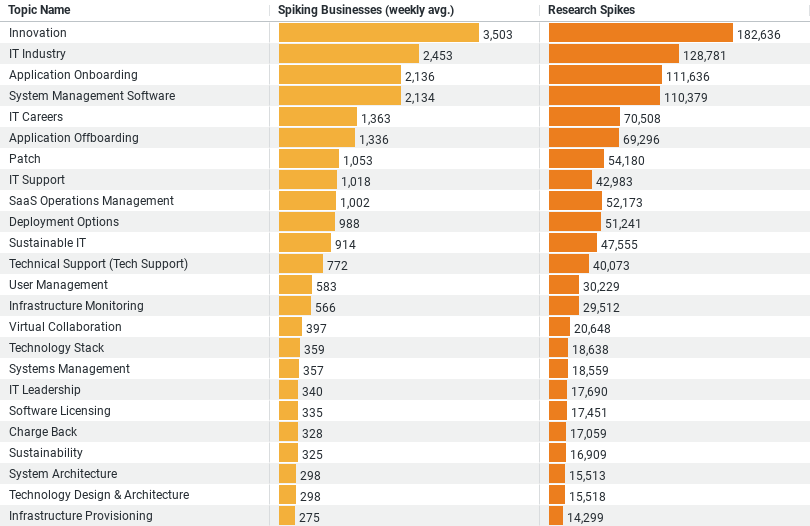Executive Summary: IT Management Trends in the Construction Industry
1. Innovation has an average of 3,502.77 weekly spiking businesses and 182,636 research spikes.
2. IT Industry is associated with 2,453.38 weekly spiking businesses and 128,781 research spikes.
3. Application Onboarding shows 2,135.85 weekly spiking businesses and 111,636 research spikes.
4. System Management Software has 2,133.69 weekly spiking businesses and 110,379 research spikes.
5. IT Careers feature 1,363.08 weekly spiking businesses and 70,508 research spikes.
This summary provides insights into current trends and interests within the IT field, highlighting areas with significant business and research activity.
In the ever-evolving landscape of the construction industry, the integration of Information Technology (IT) management has become increasingly crucial. As companies strive for innovation, efficiency, and competitive advantage, understanding the intersection between construction and IT management provides valuable insights into the future direction of the sector. This blog post delves into recent trends within the IT field, specifically highlighting how the construction industry’s interests align with areas like innovation, IT industry developments, application onboarding, system management software, and IT careers.
Innovation at the Forefront
The construction industry’s keen interest in innovation is evident, with an average of 3,502.77 weekly spiking businesses and a remarkable 182,636 research spikes. This enthusiasm underscores a pivotal shift towards adopting novel technologies and methodologies. In the realm of construction, innovation translates into leveraging advanced software for project management, utilizing Artificial Intelligence (AI) for predictive analysis, and exploring sustainable construction practices. Such technologies not only streamline operations but also enhance precision and sustainability.
Embracing the IT Industry
The construction sector’s engagement with the broader IT industry is noteworthy, with 2,453.38 weekly spiking businesses and 128,781 research spikes. This trend reflects a growing acknowledgment of the critical role that IT plays in modernizing construction processes. From cloud computing facilitating real-time collaboration across project sites to IoT devices monitoring construction progress and equipment health, the synergy between construction and IT is paving the way for smarter, more connected job sites.
Application Onboarding: A Key Focus
With application onboarding seeing 2,135.85 weekly spiking businesses and 111,636 research spikes, there’s a clear focus on integrating new software applications seamlessly into construction operations. Effective onboarding ensures that teams can quickly adapt to new tools, reducing downtime and improving productivity. This is particularly relevant in construction, where the adoption of digital blueprints, project management platforms, and communication tools is essential for project success.
System Management Software in the Spotlight
The interest in system management software, with 2,133.69 weekly spiking businesses and 110,379 research spikes, highlights its importance in overseeing and optimizing IT resources within construction. Effective system management enables companies to maintain robust IT infrastructure, ensuring that project data is securely managed, and resources are allocated efficiently. For construction projects that rely heavily on data accuracy and availability, such software is indispensable.
Fostering IT Careers within Construction
Lastly, the focus on IT careers, indicated by 1,363.08 weekly spiking businesses and 70,508 research spikes, emphasizes the industry’s need for skilled IT professionals. As construction companies increasingly rely on sophisticated IT solutions, the demand for expertise in areas such as cybersecurity, data analysis, and software development has surged. This trend not only opens up new career paths within the construction industry but also underscores the sector’s commitment to embracing IT innovations.
The Road Ahead
The construction industry’s interest in IT management is more than a fleeting trend; it’s a fundamental shift towards a more technologically integrated future. As companies continue to explore and invest in IT solutions, the potential for innovation and efficiency gains is immense. The key to harnessing these benefits lies in strategic investment, continuous learning, and cross-disciplinary collaboration.
Conclusion
he intersection of construction and IT management is shaping the future of the industry. By embracing IT innovations, the construction sector can achieve greater efficiency, sustainability, and competitiveness. As this trend continues to evolve, staying informed and adaptable will be crucial for companies looking to thrive in the digital age. The insights derived from recent IT trends provide a roadmap for the construction industry, guiding strategic decisions and investments in technology that will define the future of construction projects worldwide.
Company Sample Data
The image above contains insightful data on the distribution of interest in IT-related topics across companies of various sizes. Here’s a concise overview based on the initial rows of the dataset:
1. Micro (1 – 9 Employees): This category has an average of 1,389.87 weekly spiking businesses, representing 10.07% of the total. This reflects the significant interest in IT within micro-sized companies, highlighting their engagement with technology trends despite their small size.
2. Small (10 – 49 Employees): Small companies show a higher level of activity, with 4,192.85 weekly spiking businesses, accounting for 30.37% of the total. This indicates a robust interest in IT, suggesting that small businesses are keen to leverage technology for growth and efficiency.
3. Medium-Small (50 – 199 Employees): Almost mirroring small companies, medium-small businesses have 4,208.96 weekly spiking businesses, making up 30.49% of the total. This similarity suggests a consistent interest in IT as companies grow, highlighting the importance of technology in scaling operations.
4. Medium (200 – 499 Employees): Medium-sized companies, with 1,791.33 weekly spiking businesses, represent 12.98% of the total. While there’s a decrease compared to smaller companies, the interest remains significant, indicating ongoing IT investments.
5. Medium-Large (500 – 999 Employees): This group has 833.62 weekly spiking businesses, accounting for 6.04% of the total. The lower percentage suggests that as companies grow larger, the relative volume of spiking businesses in IT might decrease, possibly due to established IT systems or different focus areas.
This dataset reveals interesting patterns in how companies of different sizes engage with IT-related topics. Smaller companies show a high level of engagement, which slightly tapers off as companies grow in size. However, the consistent presence of interest across all categories underscores the universal importance of IT in today’s business landscape.



